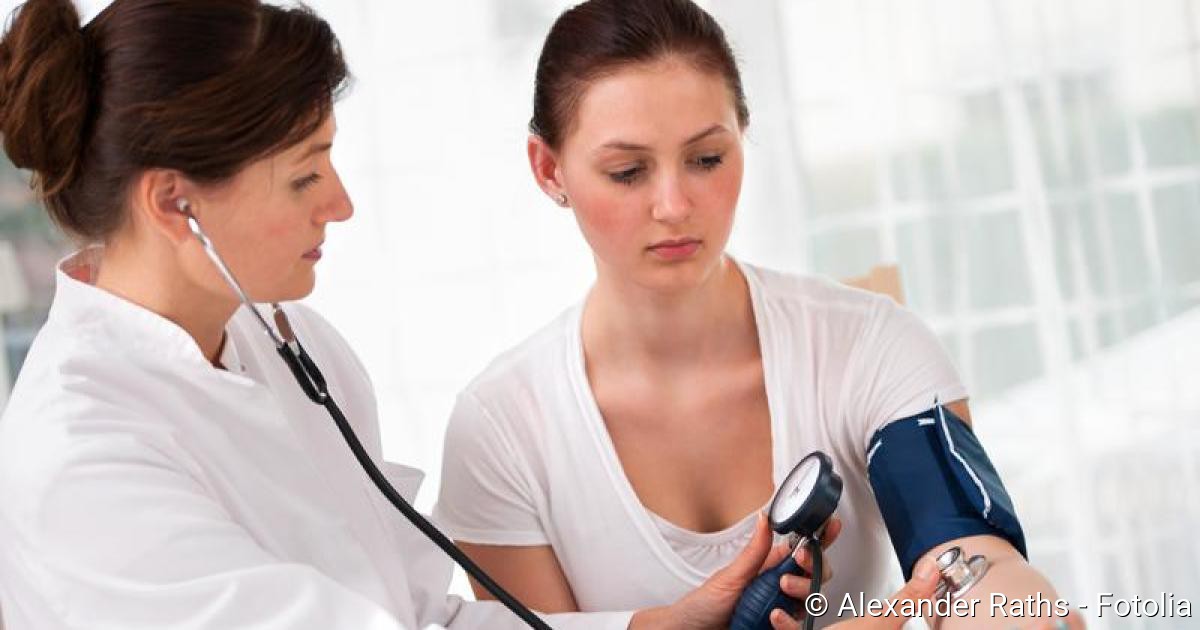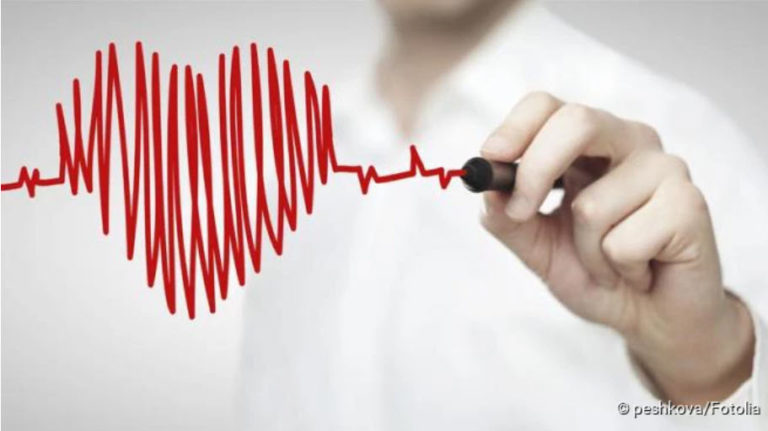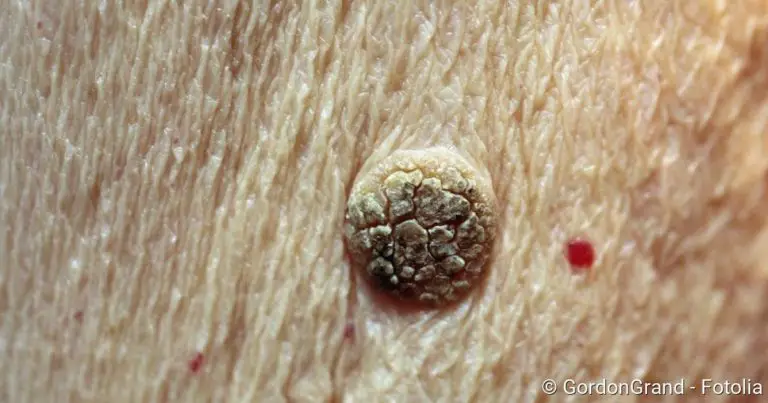Low blood pressure: limits, symptoms, causes
Low blood pressure: limits, symptoms, causes
Low blood pressure is actually only a symptom and not a disease or a condition, although it is often considered as such by people. We took the editorial decision to include it in this category, as people is searching for it within our “Conditions” category.
Low blood pressure (arterial hypotension) is common, especially in young, slim women. We speak of low blood pressure when blood pressure values are below 100/110 to 60 mmHg. Those affected usually suffer from dizziness, tiredness or palpitations. Read more about: How does low blood pressure develop? What to do about it? Why can low blood pressure be dangerous during pregnancy?

Brief overview
- Limit values: 110 to 60 mmHg for men, 100 to 60 mmHg for women
- Symptoms: sometimes none, but often complaints such as palpitations, dizziness, headaches, fatigue, shortness of breath
- Causes: Low blood pressure is partly hereditary. However, it can also be caused by environmental influences, diseases or medication as well as certain postures or (rapid) changes of position.
- Diagnosis: repeated blood pressure measurement, certain circulatory tests, if necessary further examinations (such as ultrasound and blood tests)
- Treatment: Household remedies and general measures such as alternating showers, exercise, sufficiently salted food, lots of drinking; if all this does not help: medication
- Prognosis: usually harmless, only in certain cases exact observation necessary.
Low blood pressure: Limit values table
The term blood pressure refers to the pressure in the major arteries. These are the vessels leading away from the heart. How high or low the pressure inside them is depends on the elasticity and resistance of the vessel walls. On the other hand, blood pressure is influenced by the power of the heart – i.e. how much blood volume per heartbeat is transported into the circulation. The heart rate also plays a role.
Blood pressure is expressed in “millimetres of mercury” (mmHg). The upper (systolic) value describes the blood pressure at the moment when the heart muscle contracts and ejects blood. The lower (diastolic) value refers to the relaxation phase of the heart (slackening) when it fills with blood again.
Low blood pressure: values
According to the World Health Organization (WHO), blood pressure should ideally be below 120 to 80 mmHg. If the systolic value is below 110 (men) or 100 (women) and the diastolic value below 60, doctors speak of low blood pressure (arterial hypotension). The table shows how deviations from the optimum value are assessed upwards:
| Systolic (mmHg) | Diastolic (mmHg) | |
| Low blood pressure (hypotension) | < 110/100* | < 60 |
| Optimal blood pressure | < 120 | < 80 |
| Normal blood pressure | 120 – 129 | 80 – 84 |
| High normal blood pressure | 130 – 139 | 85 – 89 |
| High blood pressure (hypertension) | ≥ 140 | ≥ 90 |
* For men, values below 110/60 are considered low blood pressure, for women values below 100/60.
Low blood pressure is rarely threatening. Only if the values drop too much can low blood pressure become dangerous – there is a risk of fainting. Occasionally, arterial hypotension is an indication of a potentially serious organ disease.
Low blood pressure: symptoms
Low blood pressure does not always cause symptoms. However, especially in the case of rapid blood pressure attacks, symptoms such as dizziness, palpitations and circulatory problems, headaches or fatigue can occur. Frequently affected are (inactive) pubescent, young slim women, pregnant women and gaunt elderly people. In principle, if low blood pressure causes symptoms such as the following and these occur frequently or very suddenly, the cause should be clarified by a doctor:
Tachycardia: If the blood pressure is low, a fast heartbeat (pulse) often accompanies it. This is because the body wants to counteract the reduced blood circulation – and it does so by activating the sympathetic nervous system to make the heart beat faster.
Dizziness: Low blood pressure also means lack of blood supply to the brain. This causes visual disturbances such as the famous “seeing stars” or “turning black before the eyes”, ringing in the ears and dizziness. In the worst case, those affected will faint. Often these symptoms also become noticeable when affected persons change position, for example when they stand up (quickly) or bend down. The blood sinks into the legs and the body needs a moment to regulate the blood pressure.
Such “dropouts” become dangerous if there is a danger of falling or if they occur while driving.
Headaches: Low blood pressure is often accompanied by (stabbing, pulsating) headaches. The reason: The blood circulation in the head is reduced. Then it may help to drink something and thereby increase the circulating blood volume. A walk is also good for you, as the fresh air improves the supply of oxygen to the brain and stimulates the circulation.
Tiredness: fatigue, concentration problems, dizziness, tiredness – low blood pressure makes you tired Patients take longer to get going in the morning and feel generally lacking in drive. They are also often shaky or sweaty due to reduced blood circulation.
Shortness of breath: A tightness in the chest or stitches in the heart area can also be signs of low blood pressure. Some people have difficulty breathing, the skin may feel cool and pale. This is because in arterial hypotension, the blood vessels are narrowed to direct the blood volume to the vital organs such as the heart or brain.
Noises in the ears, loss of appetite, irritability, sensitivity to the weather and depressive moods can also indicate low blood pressure.
Although low blood pressure is rarely dangerous, those affected often suffer from unpleasant symptoms.
Low blood pressure: causes and risk factors
In itself, the body has its own system that regulates blood pressure – small pressure measuring corpuscles in the carotid arteries that can feel the blood pressure in the vessel. They transmit signals to the circulatory centre in the brain stem. This gives the command for vasodilatation in case of high blood pressure and the command for vasoconstriction in case of low blood pressure. The kidney also becomes active if the blood pressure in the supplying vessel drops too far: She then releases the hormone renin. It triggers an increase in blood pressure via intermediate steps.
The mechanisms of blood pressure regulation may not function adequately or may be disturbed for a variety of reasons. This results in low blood pressure. Doctors distinguish between different forms of hypotension: primary (essential) hypotension, secondary hypotension and orthostatic hypotension.
Primary hypotension
Primary or essential low blood pressure is the most common form of hypotension. It occurs without a recognisable cause. However, the tendency to do so may well be inherited. Because young, slim people (especially women) often have a congenital low blood pressure, this is also referred to as constitutional hypotension (constitution = build, general physical condition).
Secondary hypotension
Secondary low blood pressure is a consequence or symptom of an underlying disease. These include, for example:
- Hypothyroidism (hypothyroidism)
- Hypofunction of the adrenal cortex (Addison’s disease)
- Hypofunction of the pituitary gland (anterior pituitary insufficiency)
- Heart diseases (heart failure, cardiac arrhythmia, pericarditis)
- Salt deficiency (hyponatremia)
- Vein weakness (varicose veins)
A lack of fluid (in hot weather, through heavy sweating, severe diarrhoea and vomiting, etc.) can also lower blood pressure: the great loss of fluid reduces the amount of circulating blood, causing the pressure in the vessels to drop.
Also as a side effect of some medications, blood pressure can drop excessively. Such drug-induced hypotension can be triggered by:
- Psychotropic drugs (medicines for depression, anxiety, insomnia)
- Antiarrythmics (drugs against cardiac arrhythmia)
- Antihypertensive drugs (medicine against high blood pressure)
- Diuretics (diuretic drugs)
- Coronary medication (for angina pectoris: nitro sprays)
- Vasodilators (vasodilating agents)
Orthostatic hypotension
Orthostasis refers to the upright posture of the body. Correspondingly, orthostatic low blood pressure occurs when you get up quickly from a lying position and the blood in your legs is absorbed. This results in a volume shift to which the body cannot react sufficiently (quickly). Orthostatic hypotension is therefore also called orthostatic dysregulation.
Possible reasons for orthostatic hypotension are:
- secondary hypotension
- Disturbance of the autonomic nervous system (for example through diabetes mellitus)
- Nerve cell damage in the brain (e.g. through Parkinson’s disease, alcohol abuse)
- Varicose veins (varicosis)
- Condition following deep vein thrombosis of the leg (postthrombotic syndrome)
Physicians distinguish two forms of orthostatic hypotension:
- Sympathicotonic orthostatic hypotension: After getting up, the systolic blood pressure drops while the pulse rate increases.
- Asympathicotonic orthostatic hypotension: Systolic and diastolic blood pressure drop when getting up, while the pulse rate remains unchanged or also drops.
Low blood pressure during pregnancy
During the first six months of pregnancy low blood pressure is normal. But sometimes it remains too low even in late pregnancy. The reason for this can be the vena cava syndrome: The unborn child presses on the great vena cava of the mother. This large blood vessel carries blood from the body back to the heart. The child’s pressure on the great vena cava therefore impairs the blood return to the heart. As a result, the blood supply to the brain and other parts of the body is reduced, resulting in low blood pressure.
Low blood pressure: examinations and diagnosis
In order to be able to make a diagnosis of “low blood pressure”, the doctor must measure the blood pressure repeatedly. It is usually important that the measurements are taken on different days and at different times.
The tilt table examination is especially used for patients who have fainted once before due to circulatory problems. During the test, the patient is tied on a tilting table with two straps. Heart rate and blood pressure are monitored. After a ten-minute rest period while lying down, the tilting table is quickly erected to a tilt angle of 60 to 80 degrees. So the fast rising from a lying position is simulated to see if blood pressure and pulse drop and the patient faints. If this is the case, one speaks of so-called vasovagal syncope (fainting as a result of an excessive reaction of the vagus nerve, which is part of the autonomous nervous system).
On the other hand, low blood pressure as a result of poor orthostatic regulation (orthostatic hypotension) can be detected using the Schellong test. In this circulatory test, the patient must first lie down for ten minutes and then get up quickly and remain standing for ten minutes. In orthostatic hypotension, the rapid change of position causes a drop in blood pressure and possibly other symptoms (such as dizziness).
If the doctor suspects that too low blood pressure is caused by a certain underlying disease (secondary hypotension), further examinations can provide clarity. For example, in order to clarify hypothyroidism, the thyroid gland values in the blood are measured and the thyroid gland is examined using ultrasound. Electrocardiography (ECG) can provide indications of heart disease (such as rhythm disturbances).
Low blood pressure: treatment
The good news is that as bothersome as the symptoms of low blood pressure can be, home remedies and a few simple measures can usually alleviate the discomfort noticeably. Drug therapy is only necessary if low blood pressure causes serious symptoms or a health hazard.
Low blood pressure: home remedy
So what exactly can you do if your blood pressure is low? First of all, move. Physical activity gets the circulation going and reduces symptoms such as dizziness and fatigue. Especially endurance sports such as jogging, swimming or cycling are suitable for this.
By the way, movement starts before you get up: It often helps to alternately stretch and bend your feet in bed to stimulate blood flow, or to cycle with your feet in the air. Only then raise it slowly – if necessary with a pause for sitting on the edge of the bed.
Blood pressure fluctuations when getting up in the morning can often be prevented by sleeping at night with a raised upper body (head rest at an angle of about 20 degrees).
Other home remedies for low blood pressure are compression/support stockings. They can stimulate the blood circulation in the legs.
Taking a shower instead of a full bath is also a good tip for people with low blood pressure. If you don’t want to do without the full bath, you should make sure that the bath water is not too warm and that you only get out of the tub very slowly at the end. Due to the heat, the vessels are dilated, which is why the blood can easily sink into the legs when getting up.
Alternate showers are very useful for low blood pressure: The rapid change between warm and cold water causes the blood vessels to alternately dilate and contract again. This trains the vessel walls and stimulates the circulation.
If you are afraid of a whole body sprinkling with cold water, you can at least take a cold shower on the lower half of the body – from the feet upwards to the buttocks. A circulation-enhancing brush or a massage sponge increase the stimulating effect.
Talking of stimulating effects: A cup of coffee in the morning also has that effect. Green or black tea also has a stimulating effect on the circulation. In general, you should drink a lot if your blood pressure is too low (water, herbal or fruit tea, etc.) This increases the blood volume and thus the blood pressure.
Common salt also increases blood volume and blood pressure by binding fluid in the body. People with low blood pressure should therefore salt their food sufficiently (maximum five grams per day). It is also advisable to have several small meals a day instead of a few large ones.
If your blood pressure is low, you should also limit your alcohol consumption. Alcohol dilates the blood vessels, causing blood pressure to drop, at least in the short term.
Saponins are also said to have a positive effect on low blood pressure. These plant substances are found, for example, in liquorice, oats and legumes. They can increase the production of cortisol in the body and thus raise blood pressure.
Some medicinal plants can also stimulate the circulation. These include, for example, ginseng, hawthorn and rosemary. Some medicinal plants can be used to prepare a tea, others are available as herbal preparations. Ask your doctor or pharmacist for advice.
Low blood pressure: medication
If home remedies and general measures (lots of exercise etc.) do not sufficiently relieve the symptoms of low blood pressure, you should talk to your doctor about drug treatment. However, he will only prescribe such medication if it is absolutely necessary. This is because all active ingredients used can also have side effects.
The following active ingredients are available for the treatment of low blood pressure:
- Sympathomimetics: These active ingredients (e.g. etilefrin, caffeine) constrict the blood vessels and increase the heart rate, which causes the blood pressure to rise. Possible side effects: Cardiac arrhythmia.
- Fludrocortisone: This active ingredient raises blood pressure by increasing the amount of fluid in the blood vessels. Possible side effects: Fluid retention in the tissue (oedema), weight gain and potassium deficiency.
In the past, so-called dihydroergotamines were also given in cases of low blood pressure. However, due to pronounced side effects, they may no longer be prescribed for orthostatic hypotension since 2014.
Low blood pressure: course and prognosis
As a rule, low blood pressure is not dangerous and does not cause permanent damage. In severe cases, however, it can lead to severe dizziness and fainting.
Low blood pressure during pregnancy can also be dangerous: It can happen that the uterus is not sufficiently supplied with blood. Then the care of the unborn child is no longer guaranteed. Such permanent undersupply of the child can lead to developmental disorders and increase the risk of complications at birth. Therefore low blood pressure during pregnancy should be carefully controlled and monitored by a doctor.






